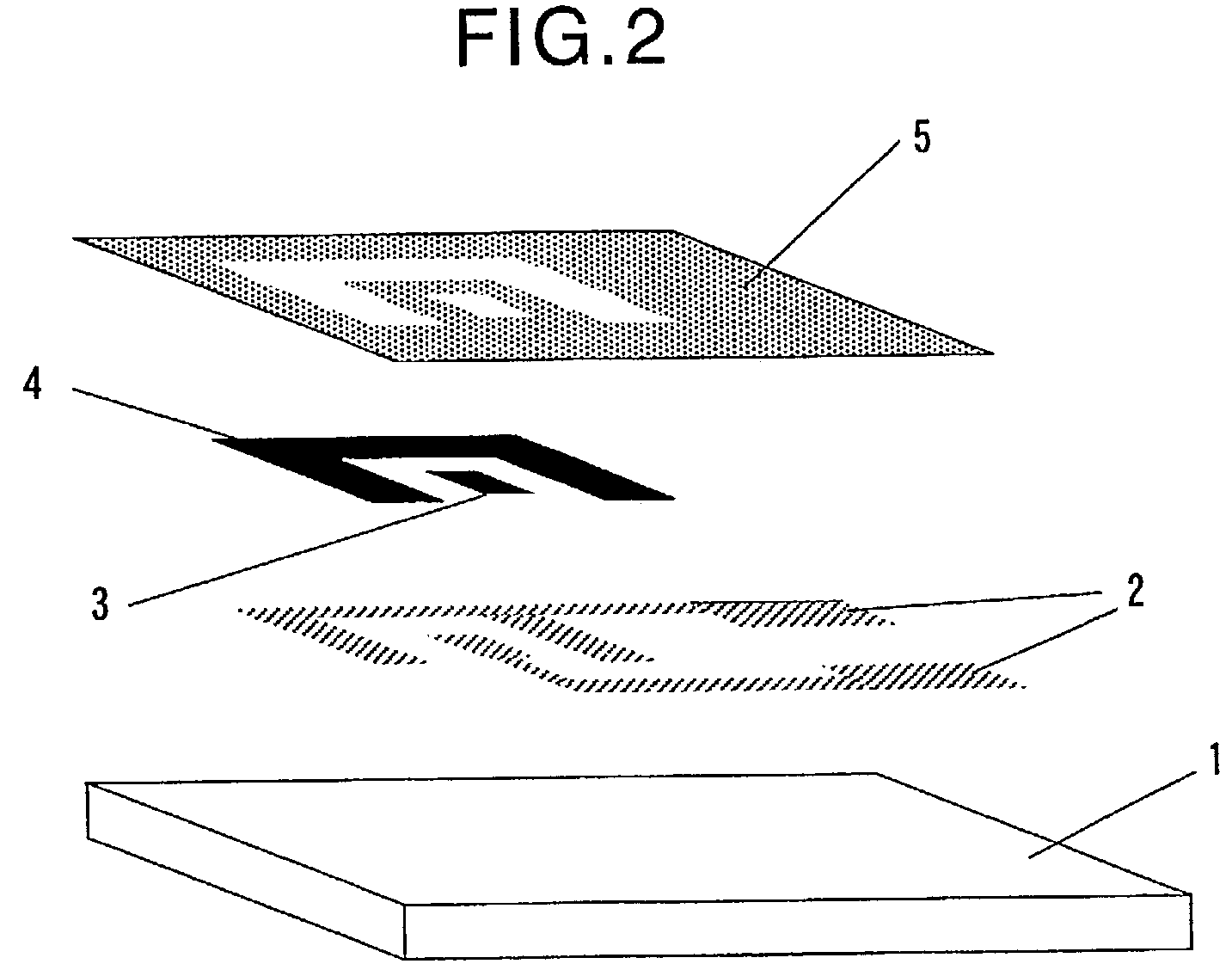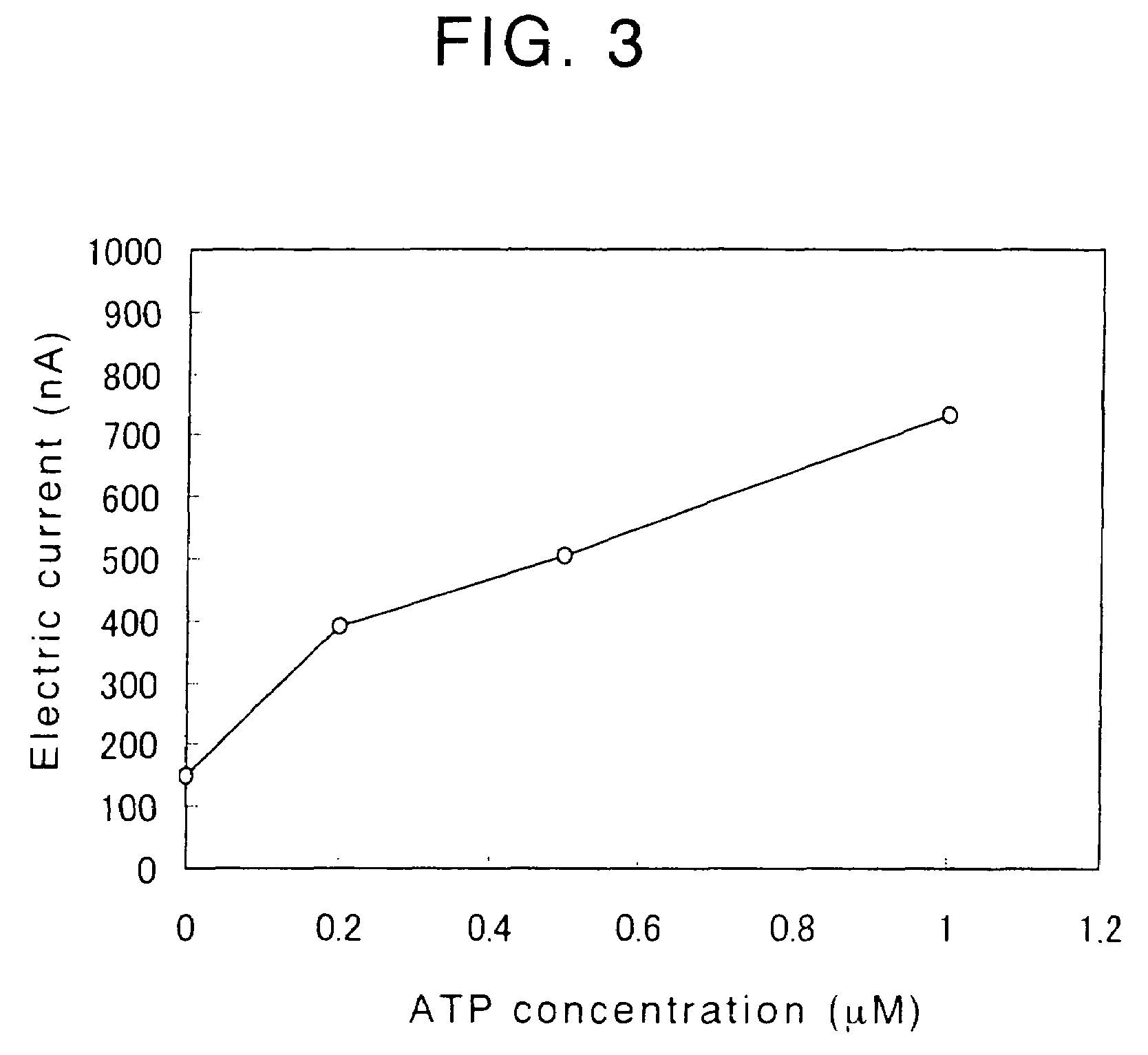Enzyme electrode
a technology of enzyme electrodes and electrodes, applied in the field of enzyme electrodes, can solve the problems of inability to suitably use the above-mentioned method in analyses, high equipment requirements, and difficult movement, and achieve the effects of high sensitivity, easy and rapid determination, and high sensitivity
- Summary
- Abstract
- Description
- Claims
- Application Information
AI Technical Summary
Benefits of technology
Problems solved by technology
Method used
Image
Examples
reference example 1
[0215]An experiment was performed to confirm that a reaction layer comprising diaphorase (DI), 12α-hydroxysteroid dehydrogenase (12α-HSD) and nicotinamide adenine dinucleotide synthetase (NADS) can be used as a reaction layer of an enzyme electrode for determining the concentration of adenosine triphosphate (ATP).
[0216]A 25% (w / v) aqueous trehalose solution containing 3,200 U / ml of DI (catalogue no. T-06, manufactured and sold by Asahi Kasei Corporation, Japan), 9,600 U / ml of 12α-HSD (catalogue no. T-29, manufactured and sold by Asahi Kasei Corporation, Japan) and 880 U / ml of NADS (catalogue no. T-67, manufactured and sold by Asahi Kasei Corporation, Japan) was prepared and 0.5 μl of the prepared aqueous trehalose solution containing DI, 12α-HSD and NADS enzymes was mixed with 0.25 μl of a 1% (v / v) aqueous glutaraldehyde solution to thereby obtain a mixture. A mirror-finished, glassy carbon electrode having a diameter of 3 mm (catalogue no. 11-2012, manufactured and sold by BAS Inc....
example 1
[0227]An electrode system which comprises insulating layer 5 shown in FIG. 1(c) was prepared by screen printing.
[0228]A PET film having a thickness of 188 μm (trade name: Melinex S, manufactured and sold by Du Pont Co. Ltd., Japan) was used as insulating substrate 1. Electric leads 2, 2 were formed on insulating substrate 1 by screen printing using a silver paste (catalogue no. FA-353, manufactured and sold by Fujikura Kasei Co., Ltd., Japan) and a resist (catalogue no. XC-101G, manufactured and sold by Fujikura Kasei Co., Ltd., Japan) (see FIG. 1(a)).
[0229]Next, working electrode 3 and counter electrode 4 were, respectively, formed in association with electric leads 2,2 by screen printing using a carbon paste (catalogue no. FC-415, manufactured and sold by Fujikura Kasei Co., Ltd., Japan) and the above-mentioned resist, to thereby obtain an electrode system precursor (see FIG. 1(b)). The shape of working electrode 3 was a square of 4 mm×4 mm.
[0230]On the thus obtained electrode sys...
example 2
[0243]An electrode system was prepared in substantially the same manner as in Example 1 except that the shape of the reaction layer was changed to a square of 4 mm×4 mm (thus, the surface area of the reaction layer was the same as that of the working electrode, namely 0.16 cm2).
[0244]3 μl of a 0.5% (w / v) aqueous carboxymethylcellulose (CMC) solution was dropped on the working electrode of the above-mentioned electrode system, followed by drying, to thereby form a CMC layer on the working electrode of the electrode system.
[0245]6 μl of an aqueous solution containing 2.1 mg / ml (100 U / ml) of DI (which is the same as used in Reference Example 1), 4.6 mg / ml (1,000 U / ml) of 12α-HSD (which is same as used in Reference Example 1), 1.5 mg / ml (50 U / ml) of NADS (which is the same as used in Reference Example 1) and 2.5 mg / ml of bovine serum albumin (BSA) was dropped on the CMC layer, followed by drying, to thereby immobilize the enzymes contained in the solution on the surface of the working e...
PUM
| Property | Measurement | Unit |
|---|---|---|
| Mass | aaaaa | aaaaa |
| Mass | aaaaa | aaaaa |
| Mass | aaaaa | aaaaa |
Abstract
Description
Claims
Application Information
 Login to View More
Login to View More - R&D
- Intellectual Property
- Life Sciences
- Materials
- Tech Scout
- Unparalleled Data Quality
- Higher Quality Content
- 60% Fewer Hallucinations
Browse by: Latest US Patents, China's latest patents, Technical Efficacy Thesaurus, Application Domain, Technology Topic, Popular Technical Reports.
© 2025 PatSnap. All rights reserved.Legal|Privacy policy|Modern Slavery Act Transparency Statement|Sitemap|About US| Contact US: help@patsnap.com



